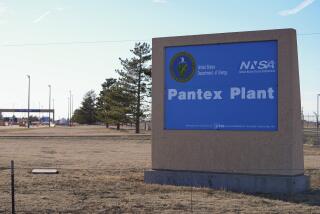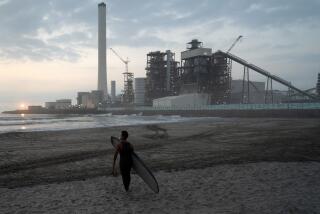Cracks in Reactors Attest to Problems at Aging Nuclear PlantsReactorWorries
WASHINGTON--Severe cracks found at one nuclear power reactor and the stunning discovery of a hole that nearly breached the 6-inch-thick steel dome of another facility are raising new questions about aging nuclear plants and whether they are being inspected closely enough.
The hole that went through most of the reactor cover at the Davis Besse power plant in Ohio and the severity of cracks found about a year earlier at a reactor in South Carolina surprised federal safety regulators and the industry.
Both incidents have had plant operators scrambling to look for cracking in reactor control rod nozzles and, more recently, for corrosive boric acid on reactor domes. It was a government-ordered inspection prompted by cracks found in South Carolina in early 2001 that led to the discovery of the David Besse hole last March.
A primary reason for the corrosion was the longtime escape through nozzle cracks of borated water from inside the Davis Besse reactor vessel, investigators concluded.
So far, no one else is reporting the kind of corrosion found at the Ohio plant. Though 14 reactors on a close-watch list have reported at least 62 nozzle cracks, most of the cracks have been fixed and the rest are on a schedule for repair, industry and government officials said.
A spokesman for Duke Power said the 23 cracks found at its three Oconee reactors at Greenville, S.C., have been fixed.
Still, the discoveries have prompted new questions about aging nuclear plants.
“It was material degradation that wasn’t expected,” acknowledged Alex Marion of the Nuclear Energy Institute, the industry’s trade group. Still, he added, the problems should not affect relicensing since the problems are identified and being dealt with.
Some industry critics disagree.
“The concern here is that with this inherently dangerous technology, when it ages it becomes more and more unpredictable in terms of how rapidly things can break, leak and crack,” said Paul Gunter, an anti-nuclear activist and industry watchdog.
Most reactors have a 40-year license, and a growing number of utilities are planning extensions.
FirstEnergy Corp.’s 25-year-old Davis Besse reactor on the shore of Lake Erie has been shut down since February, waiting for the hole in the reactor dome to be patched.
Like the reactor nozzle cracks found at the 28-year-old Oconee reactor, the hole at Davis Besse was discovered before anything serious could go wrong, experts said.
Still, federal regulators view the findings, especially at Davis Besse, so troubling that some senior officials at the Nuclear Regulatory Commission privately have characterized the cracking and corrosion as the most significant safety issue facing the industry since the Three Mile Island accident 23 years ago.
The steel reactor vessel, which encloses the reactor’s core, has always been viewed as “a sacred component” that will not be breached, said Brian Sheron, the commission’s assistant director for licensing and technology assessment. “This really challenges that assumption.”
Only a thin noncorrosive stainless steel membrane kept the hole at the Ohio reactor from bursting open. And nuclear experts say that if the cracks at the Oconee plant had been allowed to continue, the nozzle might have separated.
In both cases, thousands of gallons of radioactive water would have escaped from the reactor, raising the risk of the core’s radioactive fuel overheating and--in a worst-case scenario--possibly a meltdown and a release of radiation from the larger concrete containment building.
Industry spokesmen said they are convinced that backup safety systems would have averted more serious problems by pumping more water into the reactor than was being allowed to escape to keep the nuclear fuel safe until the reactor could be shut down.
But that’s true if everything works as planned, countered David Lochbaum, a nuclear engineer and industry watchdog for the Union of Concerned Scientists. If the emergency pumping systems become clogged with debris, if other equipment is damaged or a gauge misread as workers struggle to keep the fuel covered with water, a more serious accident might be unavoidable, he said.
The Davis Besse corrosion was caused by a buildup of boric acid from reactor cooling water that had been leaking from nozzle cracks since the mid-1990s. The first signs of corrosion appeared four years ago when rust began clogging filters, investigators said.
Despite a 1988 NRC directive to keep reactor lids free of boron, the layers of the powdery deposits hardened so much atop the dome--where access is difficult because of space and radiation exposure--that workers couldn’t pry it loose.
“If this occurred in Russia, we would be saying it could never happen here,” former NRC Commissioner Victor Gilinsky wrote in a recent commentary on the Davis Besse discovery, calling it “a narrow escape” from a potentially catastrophic accident.
But the company’s engineers did not link the rust to safety-related corrosion and were assured that the boron powder was harmless since they believed that heat from the reactor would evaporate any moisture.
But it is now believed that the water leaking from nozzle cracks, rather than evaporating, settled beneath the hardened layers of boron, providing enough moisture to turn the powder back into corrosive boric acid.
This produced “a whole new phenomenon,” says John Grobe, head of an NRC task force investigating the incident. “This kind of corrosion has never been seen before on a reactor pressure vessel head.”
More to Read
Sign up for Essential California
The most important California stories and recommendations in your inbox every morning.
You may occasionally receive promotional content from the Los Angeles Times.










